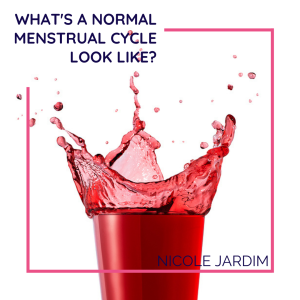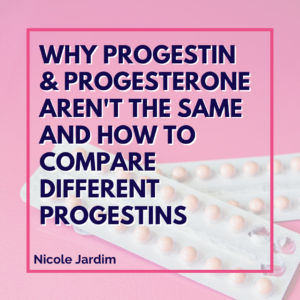“How long is my menstrual cycle supposed to be?”
“Is it normal to have clots?”
“What about the length of my actual period? Should it be 3, 4 or 5 days long?”
Remember the days of sex ed? Or more importantly, do you remember what you learned in those classes? Yeah, I don’t either! I went to a Catholic high school so my sex ed class was called Christian Family LifeEducation – I kid you not, I couldn’t make this stuff up if I tried!
My CFLE class (yes, there was an acronym) consisted of discussions on why we shouldn’t have sex. Essentially, it was no-sex education and wasn’t much help to me and my classmates. I certainly wasn’t getting the answers to the questions I posed above. Were you?
That’s probably why I’ve been asked these questions and a variation of them A LOT over the years. Women are dying for the most basic information about how the hell their bodies function.
That’s where I come in. Today I’m going to give you a walk-through of what a normal menstrual cycle actually looks like. Hopefully it will give you an idea of what your menstrual baseline is and what you should be working toward if your cycle is irregular.
What’s the normal length of a menstrual cycle?
An optimal cycle length should be anywhere from 25 to 35 days. If your cycle is 24 days or less then you might have a condition called Luteal Phase Defect, which means that your luteal phase or the second half of your cycle after ovulation is too short to either get pregnant or stay pregnant.
Note: LPD is typically caused by low progesterone – remember, progesterone is produced in the second half of your cycle after you ovulate. Once the little follicle in your ovary has released an egg, this follicle turns into what is known as a corpus luteum and it produces progesterone. So it’s safe to say that lack of ovulation or sporadic ovulation can lead to low progesterone.
The Follicular Phase
The follicular phase begins on the first day of your period and ends the day before ovulation. It’s length can vary greatly but it needs to be a minimum of 11 days in order for it to be a fertile cycle.
If you have a short follicular phase, it could mean you don’t have enough estrogen to do the job in the first half, or there is too much progesterone.
If you have a long follicular phase, it could mean you have too much estrogen which can delay ovulation.
Ovulation
First, it is SO IMPORTANT that you are ovulating. If you’re not ovulating then you need to be, because believe it or not, it is the star of the show (not your period!). Ovulation does not necessarily occur on day 14 of your cycle – don’t let anyone tell you that it should! It typically occurs between days 12 – 17 and is affected by a number of factors including diet and STRESS! If you have PCOS, it may occur much later in your cycle, causing you to have longer menstrual cycles.
You should begin to notice wetter quality cervical fluid as ovulation approaches, and the actual event typically occurs on the last wet day. Your cervical fluid will either become sticky or dry up beginning the day after ovulation due to rising progesterone levels.
The Luteal Phase
The luteal phase begins the day after ovulation and lasts until the day before your period. It should be 10-14 days long but closer to 14 days is best. It physically cannot last longer than 16 days – you’re either pregnant or you did not ovulate.
If it is less than 10 days long then you might have Luteal Phase Defect. If it’s more than 14 days long then there is probably another issue, possibly PCOS (lack of or sporadic ovulation) or something else causing a long luteal phase.
Your Period
Every month you should be checking out your period to make sure it is coming on time and to see what the blood looks like.
After all, it is considered to be a vital sign and a barometer of your overall health.
You should also keep tabs on how you feel physically and emotionally during the week before and the week of your period. Using a period app is a great way to keep track of all this stuff! These are My Top 3 Fertility Trackers.
How long should you period be?
Ideally, you want your period to be anywhere from 3-7 days but I’ve found 4-5 days to be ideal. Of course, that does not mean a period that is less than 4 days or more than 5 days is abnormal! It’s important for you to determine your normal, and a 3 day period might be that.
What color should your period blood be?
It should start with a nice saturated red color that’s vibrant and healthy, kind of like cranberry juice.

If your blood is: heavy, dark, clotted, clumpy – it resembles frozen crushed up blueberries, this is indicative of higher estrogen levels. Estrogen is a stimulating hormone that promotes growth of the uterine lining. When it becomes dominant over it’s counterpart Progesterone, you may experience breast tenderness, heavy periods, stubborn weight, acne, headaches/migraines and the dreaded PMS monster.
 Is this too graphic?
Is this too graphic?
Over time an estrogen/progesterone imbalance can be detrimental to your menstrual health. If you want to quick estrogen reset, check out my Fix Your Period Cleanse: A 14-Day Detox for Your Hormones. This is a super easy food-based cleanse that will kickstart your liver so it can get rid of excess estrogen more effectively.
If your blood is: thinned out, too little, lighter in color (kind of like watered down cranberry juice) this can indicate your estrogen is too low. Symptoms may include sporadic periods, vaginal dryness (lack of lubrication), low libido, hair loss and hair thinning.
Believe it or not, there should be no signs of physical or emotional PMS. It is not actually normal to feel like a maniac the week before your period! If PMS or even PMDD is an issue for you, this could be indicative of too high estrogen and not enough progesterone (the calming hormone) and you might want to consider doing my cleanse as a jumpstart to getting your estrogen working for you, rather than against you.
You can get your estrogen levels checked with this at home Female Hormone Test from Lets Get Checked. Use code Hormones20 to get 20% off all their tests.




22 thoughts on “What’s a normal menstrual cycle look like?”
Hi Nicole, Any thoughts on super long cycles (35-45 days)? Anything we can do to shorten the cycle?
Hi! I’m 69 and just started spot bleeding with heavy very very dark brown clots and have cramping as its happening. It comes and goes. Your thoughts about this?
hi I have a problem about my period . it starts and stop and start and stop . what does that mean ? do I have to see a doctor for it ? and also I have another question why suddenly when me and my husband starting to make up my vagina feels a lot of hurt ? but before its not like that . please I need an answer . im so worried bout my body.
Hi so I’m 11 and I’ve had brown/black clumpy goo and Like it looks almost like poo and there is a ok amount of blood with it.Its been like this for like 4 days
My period is spotting on and off for 2-3 weeks, and I only get a 2 and a half week break from it.
Should I see a doctor…?
i have a cycle of 5days started on 18august to23rd n my cycle is irregular but if i have my periods at any given it starts on18th i want to conceive when are my most fertile days
I cant tell if i starte dor not. Im in a huge mess please help me
Hello, I have suffered with endometriosis for several years now, But I also have questions regarding brown/black blood, periods are always heavy at the beginning large blood clots but after a day I would say the color changes then back to red kinda…..
The link to the detox doesn’t work. Can you email it to me?
There are a lot of incredible questions on here, but it’s so much easier to get clear answers in our Know Your Flow Facebook group. Just paste the following link into your browser:http://tinyurl.com/pkflo6r
There are tons of women in there who’ve had similar experiences and it’s much more private. I also have a free Period Survival Guide for you here: http://tinyurl.com/nh7y55g
During my period I usually fill up 8 diva cups at least. I also don’t ovulate until day 19, so it sounds like I have high estrogen, but my chart has high temperatures, with a coverline of 98, so does that mean my progesterone isn’t actually low?
Hi Nicole! I know that this is an old post, but what about brown spotting before your period, or as it ends? I actually have both and I’m seeing a doctor now but we don’t have a solid reason for it yet. My progesterone levels seem to be fine–that was our first concern as I had a miscarriage last year that was possibly related to low progesterone. Thanks!
We have been trying to conceive for 17 months since having a tubal reversal. I have been told we have unexplain infertility but suffer from only a 1 day, very light period. I have been told by my RE the amount doesn’t matter since my labs and lp is good. Is this correct?
I’ll send you an email Jenn x
Thanks so much for your awesome comments everyone! I figure for all of us it’s better late than never right? Feeling sooo grateful to have all of you as part of my Fix Your Period tribe!! xoxo
This is great! Good to know I’m spot on (no pun intended) and I give that thanks completely to my diet. My hormones have never felt more balanced than they do now. Thanks Nicole!
What a fantastically informative post! Thank you thank you, I’m now greatly enlightened, and dare I say it, empowered 🙂
Thank you so much Nicole, this was super helpful! As a life long sufferer of endometriosis, I think my teenage years could have been much happier with this knowledge. xo
Thank you for writing this post! Can you imagine this being taught in sex education, that would be awesome. BTW, I will never look at frozen blueberries the same way again. 🙂
Super helpful info! You are so full of knowledge, and your posts are very useful. Thanks for all you do with enlightening us women. xo
Hi Sara, I will do a post on IUD’s in the very near future. I will say that if you are bleeding heavily for three weeks a month then you should see your doctor and make sure nothing is wrong and then in my opinion, seriously consider having it removed.
Happy to consult with you about other options. Just email us at su*****@**********im.com to chat.
xoxo
Hi Nicole,
Can you please talk about IUDs? I got one so that I could end my dependence on birth control. Though, I typically bleed for 3 weeks (heavily) with one week off. Why and what should I do?
Thanks,
Sara